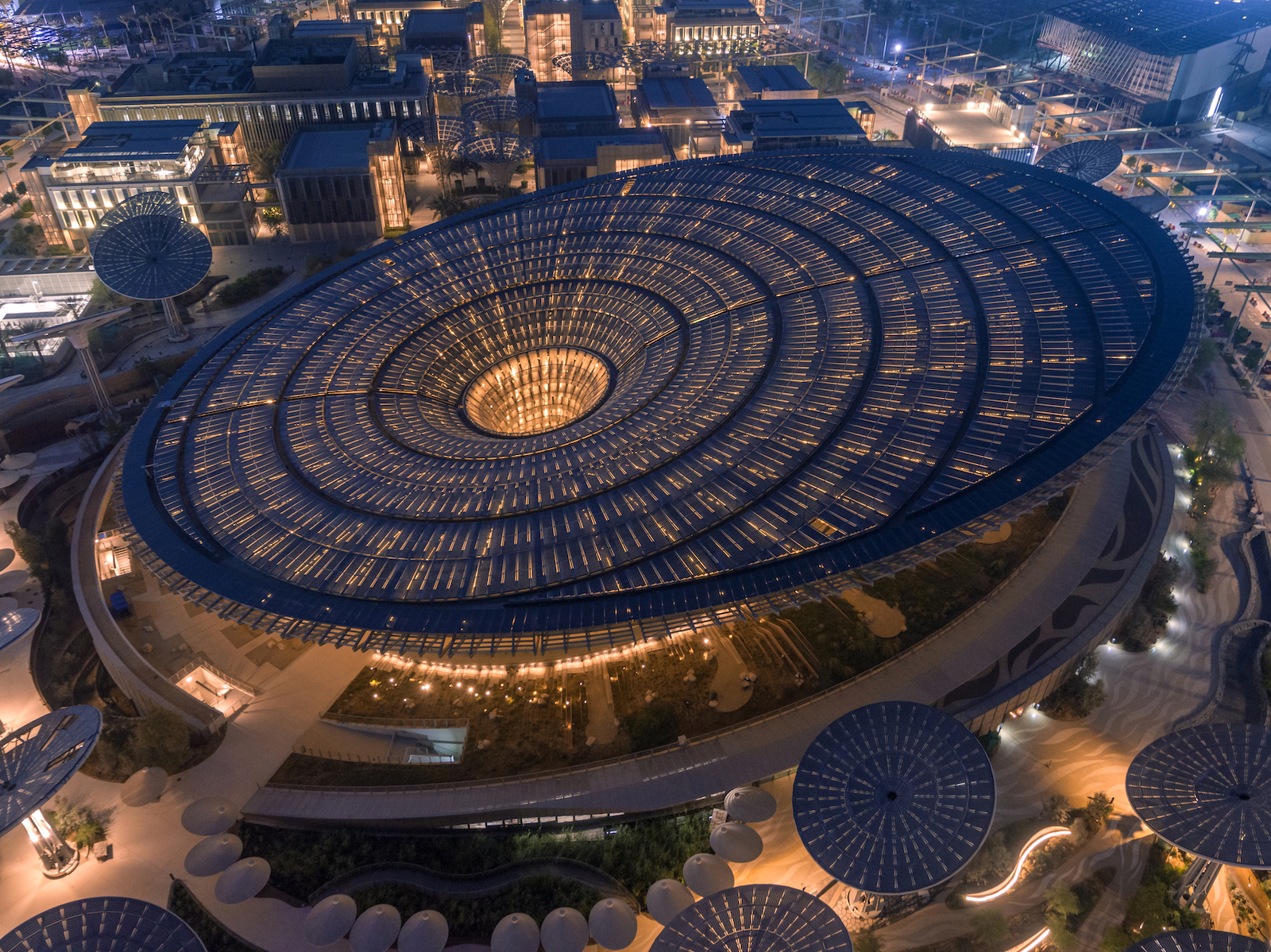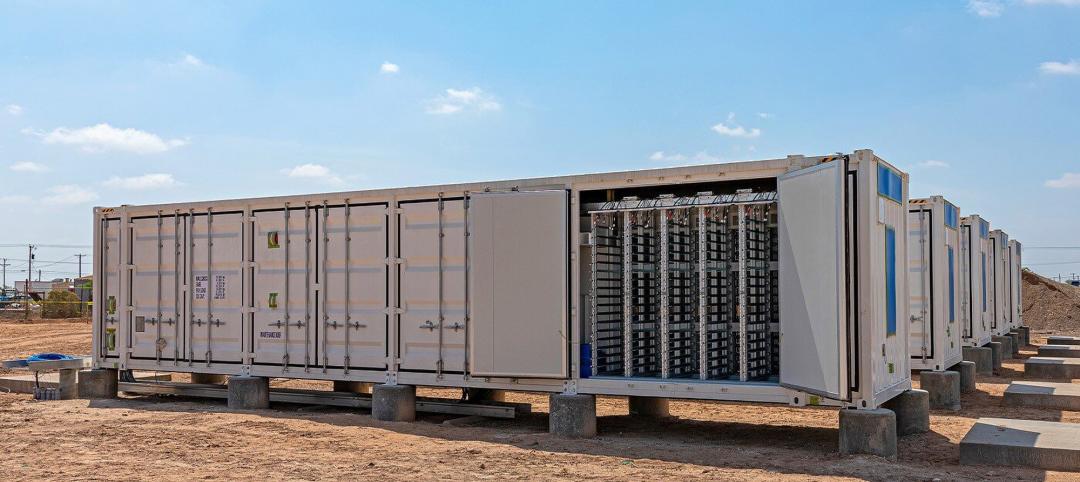Increasingly, building teams are comparing the use of building-integrated photovoltaic (BIPV) systems for façades, roofs, and other architectural assemblies with a promising and much easier alternative: conventional solar panel arrays, either on their building or off-site, to supplement their resiliency and decarbonization efforts. Recent examples include a tech company headquarters in Silicon Valley and a university in Arizona. In both cases, the project teams chose to expand their solar farms in nearby locations rather than use integrated PV technologies.
A growing group, however, is working harder. They are making BIPV an integral part of their latest green building works, contributing to a market expanding at about 15 percent per year. From the cascading glass skylights at the Edmonton Convention Center and the PV roof array overhanging the Bullitt Center in Seattle, to the new curved pavilion created for Dubai Expo and the modern PV façade at the University of Washington, creative applications generating ample electric loads are found worldwide, according to maker Onyx Solar.
“BIPV applications are challenging, and location and context are key to their early evaluations,” says John Ivanoff, an Associate Principal with Buro Happold’s façades and specialty structures team. “Arizona has more sunny days than Alaska or Maine. In some cities, there are recent code changes, such as in New York, where if the roof exceeds a certain area, the project team is required to evaluate the use of PV on the building.”
In urban contexts, neighboring buildings may cast excessive shadows, so the site itself is another aspect of the analysis, adds Ivanoff, who has worked on various innovative BIPV projects including Terra – The Sustainability Pavilion, which opened to the public in 2021 as one of the top three attractions of the Expo 2020 Dubai, UAE.
“BIPV is a challenge because the solar panels work best when on a slight angle, and vertical glass applications don’t always harness the sun in a direct enough way,” says Mark Rhoads, AIA, LEED AP, Associate Principal with Grimshaw, the architecture firm that designed Terra. “So the biggest challenges arise in applying BIPV to non-roof conditions.”
When Grimshaw and Buro Happold collaborated on Dubai’s Sustainability Pavilion, the recently completed educational venue for the client, Expo 2020 Dubai, the stakes were high. Promoting ecology, sustainable technologies, and green design, the project’s core building offers 86,000 sf of exhibition space that includes an auditorium, courtyard, and reservoir. “Soaring over the courtyard, the pavilion’s canopy accommodates more than 64,600 sf (6,000 sm) of ultra-efficient monocrystalline photovoltaic cells embedded in glass panels,” according to Grimshaw’s design team. “The combination of the cell and the glass casing allow the building to harness solar energy while providing shade and daylighting to the visitors below.”
Drawing inspiration from complex natural processes like photosynthesis, the deployable freestanding shade structures are constructed from steel and complex composites, structurally optimized to support an 18-meter photovoltaic array to harvest solar energy. Like a sunflower, the array rotates 180 degrees to follow the sun throughout the course of the day, maximizing energy yield and boosting solar cell efficiency. The bespoke trapezoidal panels employ highly efficient monocrystalline PV cells, embedded within three layers of glass, providing shade below without casting severe shadows or blocking views to the sky.
THE LATEST IN BIPV TECHNOLOGY
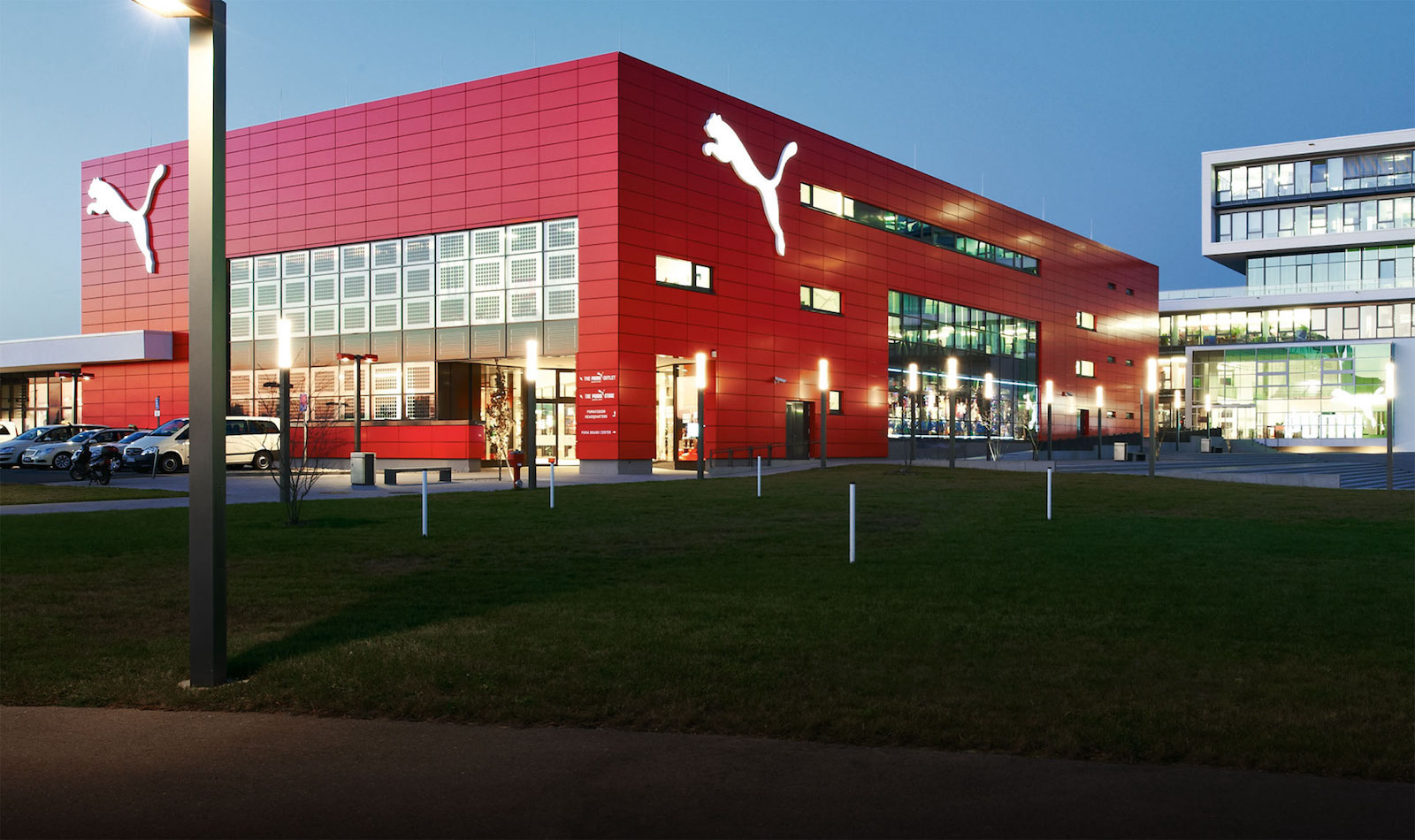
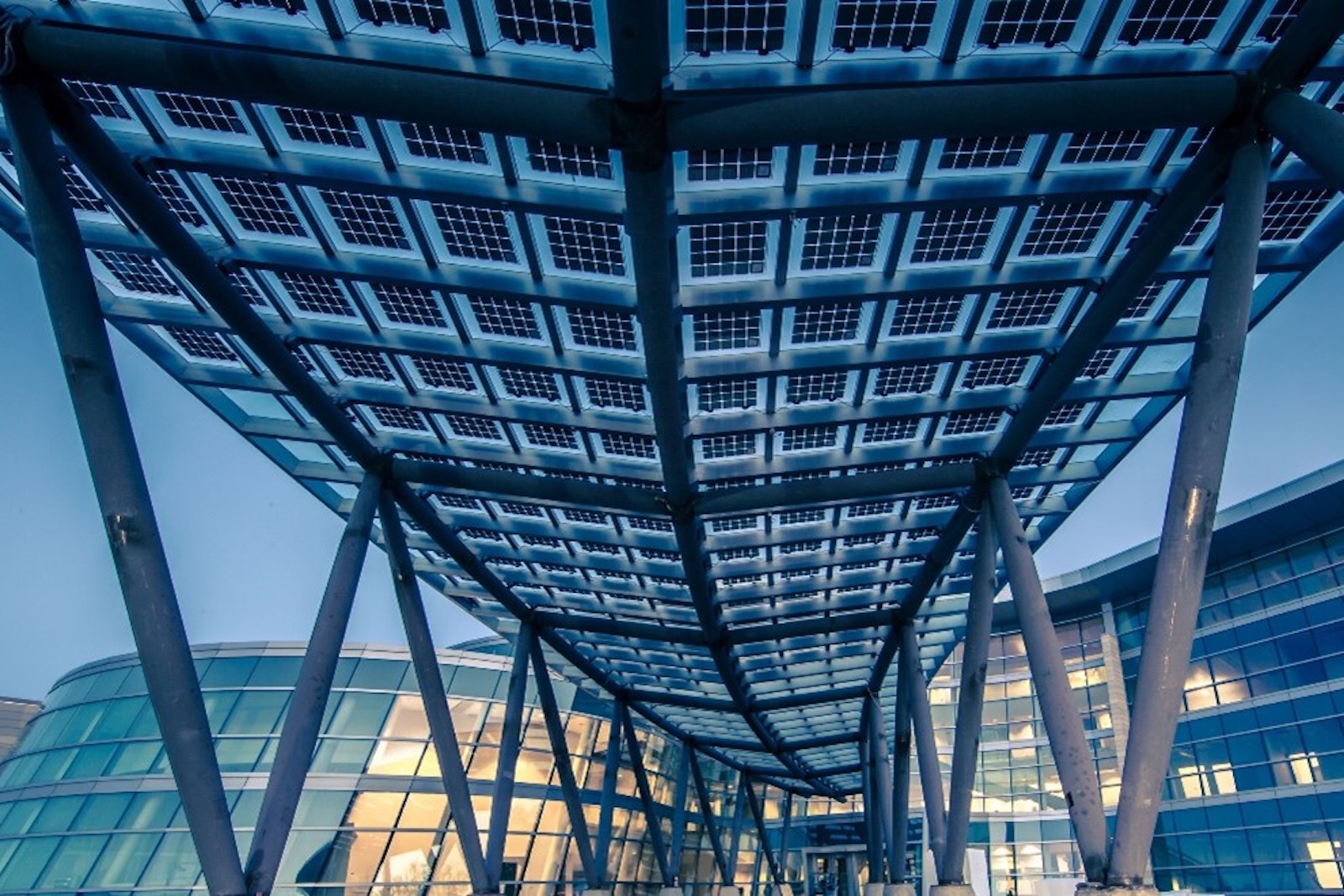
Monocrystalline solar cells represent one of four basic BIPV technologies, according to Vitro Solarvolt, a BIPV maker: “It renders a black appearance on solar cells with maximum energy-generation performance, while polycrystalline PV delivers a striking blue appearance with slightly reduced performance,” and it can be less expensive, as well. To provide a patterned appearance and higher visible light transmission (VLT) while retaining some of the energy generation benefits of monocrystalline PV, striped monocrystalline PV offers another option.
Buro Happold’s Ivanoff adds that thin film PV may be suitable for some applications. Thin films require less material, are generally cheaper but result in lower in efficiencies—110-130 peak watts per square meter (Wp/m2) versus 200 Wp/m2 for monocrystalline and 160 Wp/m2 for polycrystalline. Two thin film technologies can be integrated with glass—amorphous silicon (A-Si) and copper indium gallium selenide (CIGS)—and a third, cadmium telluride (CdTe), works for opaque panels. Vitro notes that BIPV glass panels can be used with spandrel glass, as well as low-emissivity (low-e) coatings and glass substrates, including tinted glass. Printed glass shingles are also well-established on the market, says Ivanofff, with surfaces that may be printed to look like other materials such as with a faux brick finish. Customized colored glass, he adds, is increasingly attractive to building teams.
Both Rhoads and Ivanoff stress that glass safety and fire performance should be considered, especially in horizontal and angled applications: “These are electronic elements, and in the UK, the Netherlands, and some U.S. jurisdictions it is regulated for fire safety,” says Rhoads. “Overheating is another issue in operations.” In addition to glass panels, other ways to integrate BIPV include vertically mounted high-performance panels, PV-covered louvers or shades—if those offer sufficient surface area—and street furniture integrated with PV panels, such as the bus shelters and sidewalk shade structures in Los Angeles, Singapore, and some Texas cities, says Ivanoff.
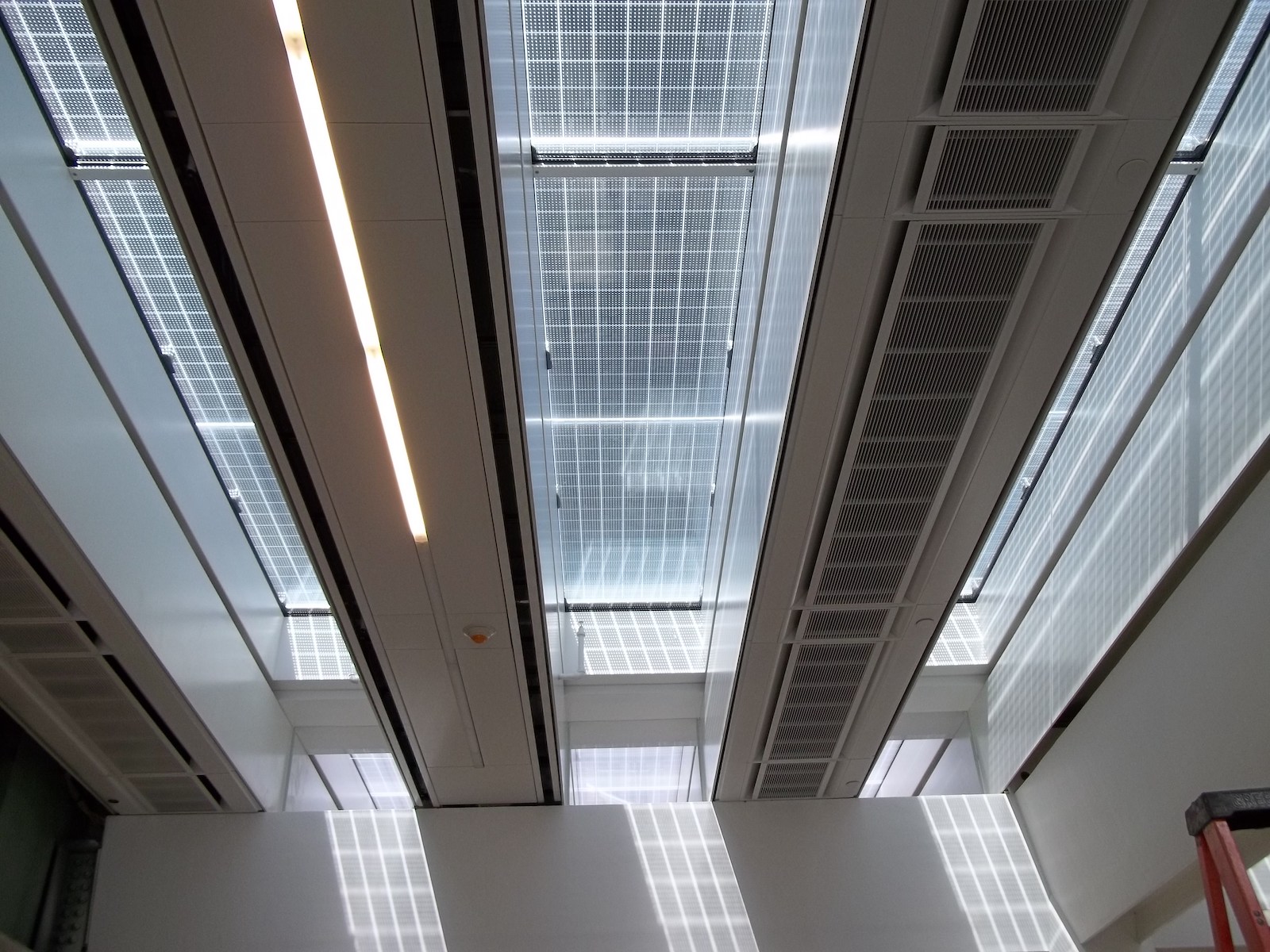
In many cases, however, skylights are seen as the ideal BIPV armature. The pharmaceutical giant Novartis opened its headquarters building a few years ago with the largest BIPV skylight in the world. “The photovoltaic skylight covers 27,500 square feet and consists of hundreds of large transparent photovoltaic glass units developed by Onyx Solar,” according to Power Engineering International, which worked with architect Rafael Viñoly Architects to complete the project. These horizontal and low-slope applications, including roof windows and solar cell covers for simple pedestrian shelters, perform optimally only when maintained well, says Grimshaw’s Rhoads: “Cleanliness is an important consideration. If your cells get covered in dust, the panels lose efficiency exponentially. So maintenance is key to keep them clean,” he explains, noting that the Dubai Expo panels are cleaned almost daily. Ivanoff adds that robotic cleaning systems used in desert solar arrays and on some new towers—along with dedicated maintenance crews—are important players in the drive to optimize efficiencies and yield of PV cells on BIPV systems over the life of the buildings.
In spite of the obstacles, Rhoads expects BIPV applications to expand as the technology becomes more ubiquitous and easy to specify. “These systems create a nice transparent condition,” he says, “and they are as integrated as possible since they power their buildings, bringing us closer to net-zero operations.”
Related Stories
Building Enclosure Systems | Oct 30, 2024
Winners of Building Envelope Innovation Prize focus on secondary glazing
The U.S. Department of Energy (DOE) recently announced the winners of the first phase of the Building Envelope Innovation Prize. The prize targets high-performance, cost-effective secondary glazing systems to improve efficiency of commercial windows.
M/E/P Systems | Oct 30, 2024
After residential success, DOE will test heat pumps for cold climates in commercial sector
All eight manufacturers in the U.S. Department of Energy’s Residential Cold Climate Heat Pump Challenge completed rigorous product field testing to demonstrate energy efficiency and improved performance in cold weather.
Engineers | Oct 23, 2024
Navigating battery energy storage augmentation
By implementing an augmentation plan upfront, owners can minimize potential delays and unforeseen costs when augmentation needs to occur, according to Burns & McDonnell energy storage technology manager Joshua Crawford.
3D Printing | Oct 9, 2024
3D-printed construction milestones take shape in Tennessee and Texas
Two notable 3D-printed projects mark milestones in the new construction technique of “printing” structures with specialized concrete. In Athens, Tennessee, Walmart hired Alquist 3D to build a 20-foot-high store expansion, one of the largest freestanding 3D-printed commercial concrete structures in the U.S. In Marfa, Texas, the world’s first 3D-printed hotel is under construction at an existing hotel and campground site.
Brick and Masonry | Oct 7, 2024
A journey through masonry reclad litigation
This blog post by Walter P Moore's Mallory Buckley, RRO, PE, BECxP + CxA+BE, and Bob Hancock, MBA, JD, of Munsch Hardt Kopf & Harr PC, explains the importance of documentation, correspondence between parties, and supporting the claims for a Plaintiff-party, while facilitating continuous use of the facility, on construction litigation projects.
AEC Tech | Sep 25, 2024
Construction industry report shows increased use of robotics on jobsites
Nearly two-thirds of contractors surveyed, who cited use of robotics on jobsites, are either using monitoring and/or service/labor robotics.
3D Printing | Sep 17, 2024
Alquist 3D and Walmart complete one of the nation’s largest free-standing, 3D-printed commercial structures
Walmart has completed one of the largest free-standing, 3D-printed commercial structures in the US. Alquist 3D printed the almost 8,000-sf, 20-foot-high addition to a Walmart store in Athens, Tenn. The expansion, which will be used for online pickup and delivery, is the first time Walmart has applied 3D printing technology at this scale.
Building Technology | Aug 23, 2024
Top-down construction: Streamlining the building process | BD+C
Learn why top-down construction is becoming popular again for urban projects and how it can benefit your construction process in this comprehensive blog.
Curtain Wall | Aug 15, 2024
7 steps to investigating curtain wall leaks
It is common for significant curtain wall leakage to involve multiple variables. Therefore, a comprehensive multi-faceted investigation is required to determine the origin of leakage, according to building enclosure consultants Richard Aeck and John A. Rudisill with Rimkus.


